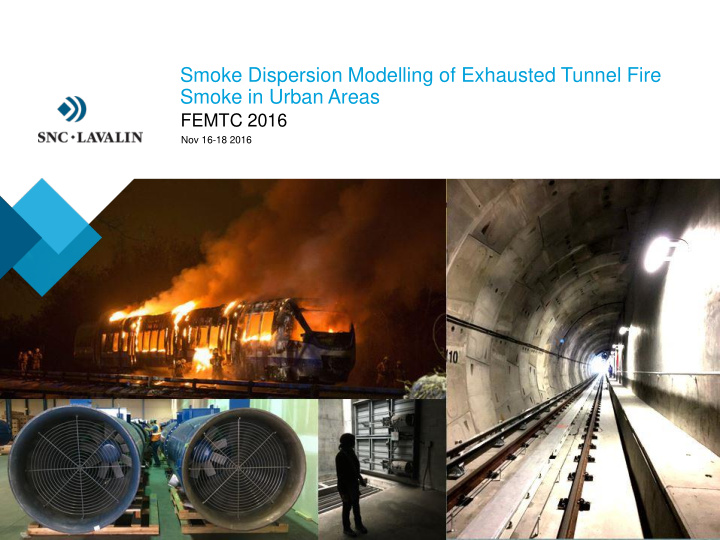



› Smoke Dispersion Modelling of Exhausted Tunnel Fire Smoke in Urban Areas › FEMTC 2016 Nov 16-18 2016
› Brian Lee › Brian.lee@snclavalin.com › Vancouver, Canada › Tunnel Ventilation Engineer
Agenda › TVS Overview › SDA Modelling Setup › Results › Q&A FEMTC 2016 – Nov 16-18, 2016
TVS – What is it? FEMTC 2016 – Nov 16-18, 2016
TVS – Comprehensive Approach Operation & Design Testing & Coordination Detailed Installation Procurement Maintenance Verification Commissioning Phase Design Phase Phase Plan Phase Phase Development Computational Fluid Dynamics Fan and Tunnel Design TVS Equipment Damper Data & Suppliers Installations System Geometries Smoke Integration O&M Dispersion Tests Analysis Equipment and Station Design Shaft, Layout Data & and Geometries Specifications Installation Installation Subway Inspection Contractors Environment Smoke Tests Training Simulations Vehicle Data
TVS Cross Section and Street Grating FEMTC 2016 – Nov 16-18, 2016
TVS Installation FEMTC 2016 – Nov 16-18, 2016
TVS: Why is it required? › Moscow Metro Fire , › June 2013 – 4,500 evacuated, 76 injuries › Cause: Power Line Failure › Daegu, South Korea , › Feb 2003 – 189 deaths, over › Baku, Azerbaijan , 100 smoke inhalation injuries, › 1995 – 220 passenger deaths, 256 smoke inhalation injuries, › Cause: Arsonist › Cause: Electrical Fault FEMTC 2016 – Nov 16-18, 2016
TVS Design – Smoke Dispersion Analysis › Emergency Mode › 3D Analysis › Aboveground Station Analysis › Underground Station Analysis › Normal and Congested Mode › 1D Analysis FEMTC 2016 – Nov 16-18, 2016
Typical Example Underground Station CFD PLATFORM LEVEL CONCOURSE LEVEL SECTION VIEW FEMTC 2016 – Nov 16-18, 2016
Smoke Dispersion Effects FEMTC 2016 – Nov 16-18, 2016
Smoke Dispersion Analysis › FDS6 › Design Validation › Examine Re-entrainment › Sensitive Receptors & Nearby Buildings FEMTC 2016 – Nov 16-18, 2016
Typical Station Layouts TVS TVS FEMTC 2016 – Nov 16-18, 2016
Smoke Temperature Calculation › Most Conservative Value › Calculate Coldest Smoke Temperatures › Warmest Ambient Temperatures › Minimal Thermally Driven Effects FEMTC 2016 – Nov 16-18, 2016
Concentration of Discharge Smoke › Conservative Estimate: One train car fire is discharged through a pair of vents: › Save Time! FEMTC 2016 – Nov 16-18, 2016
Domain Sizing (Don’t forget material assignment) FEMTC 2016 – Nov 16-18, 2016
Wind Speed and Direction › ASHRAE Guidelines suggests 1% Wind probability Sample Wind Profile Sample Wind Rose FEMTC 2016 – Nov 16-18, 2016
Street Canyon Effect › Street Canyon Effect FEMTC 2016 – Nov 16-18, 2016
Wind Profile › ASHRAE Handbook of Fundamentals › Conversion of Wind Speeds to Terrain Categories FEMTC 2016 – Nov 16-18, 2016
Wind Boundary Conditions and Domain Size Sensitivity Test Domain sizing guidelines Min 5H Height, 5H Leading, 15H Trailing Ceiling and Sides Turbulence Models LES vs RANS vs DNS FEMTC 2016 – Nov 16-18, 2016
Run Time Fully Developed Wind FEMTC 2016 – Nov 16-18, 2016
Measurement and Visualization Google Maps New Station Renderings Main Entrance Secondary Pyrosim Modelling FEMTC 2016 – Nov 16-18, 2016
Results Reporting VENTS WIND 2.0m Visibility slice above Grade FEMTC 2016 – Nov 16-18, 2016
Measurement and Visualization WIND WIND Isosurfaces: Great for Clients! FEMTC 2016 – Nov 16-18, 2016
Risk Mitigation › Vent Relocations / Height Changes › Louver Selection › Ejection Velocity › Adjacent buildings notified / HVAC Updates FEMTC 2016 – Nov 16-18, 2016
Outlook and Future › Foliage Trees and Vehicle Effects › Mesh resolutions with computing power Keep updated on large scale validation of Wind Boundary Conditions in FDS › Future applications FEMTC 2016 – Nov 16-18, 2016
Thanks for your attention! Questions? FEMTC 2016 – Nov 16-18, 2016
Recommend
More recommend